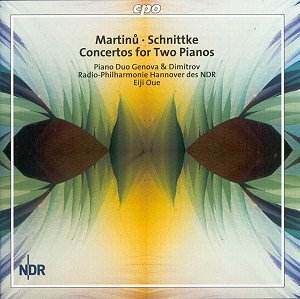Devotees of Martinů
and Schnittke will want to track down this disc. Although of
shortish playing duration and with a superficially diffuse and unfocused
programme there is quite a bit going for it.
The three movement Martinů
work is a legacy of his American wartime years when five symphonies
tumbled out in the joyous torrential spate. Those works are irradiated
by the dynamics of a scarcely containable excitement typified by the
plangent the Fourth Symphony (which I still count the best of the six).
The first movement surges with Martinů's
usual undampened melodic energy. The ten minute middle-movement adagio
only gradually declares itself as by Martinůís hand. Play its first
3 or 4 minutes, sight unseen, to most listeners and I doubt that many
will plump for Martinů. At the core of
the movement is a filigree of waves and arpeggiated motion (at times
redolent of Nancarrow's studies for player piano) that represents the
familiar though still strange Martinů. The chirpy finale is busy
and bubbly with one surreal episode at 4.09 which reminded me
of the dreamlike stasis of his opera Julietta.
Schnittke's concerto turns its face from such joy.
He seems to be exploring danker regions and unwelcoming depths. The
horror of life and its dark other half are what Schnittke seems to aim
at though he also surprises with innocence and calm as at 3.02. Anger,
slow moving kaleidoscopic metamorphosis, martellato violence
(8.02), phantasmal realms as far removed from Martinů's
sunlight as you can go. Scrambling for parallels the closest I can achieve
is to pick up Martinů's Concerto for strings, piano and timpani
- a work that looked forward towards Second World War. There worlds
are ground to dust or hymned in sorrow much as the famous Bruno
Walter Mahler 9 (only recently reissued by Naxos Historical) recorded
in Vienna in 1938 did and does.
The other two very short works are first a pastiche
Grieg experiment founded on ballet music Schnittke had written for a
Gynt ballet in 1986 (and recently toured through the German länder).
The solo violin (played by Kathrin Rabus) seems to hold up a skeletal
hand and usher us towards a much more equivocal harmonic destination:
part Schnittke-like putrescence and part nostalgic Tchaikovsky. The
Tango is part of a composite work written in 1979 for Rozhdestvensky.
The other movements were by Denisov, Pärt and the conductor himself.
This is a fascinating piece which drifts from Bach to Weill in tango
mode. It is still within hailing distance of the super-neo-Baroque works
Schnittke wrote for Gidon Kremer and which in the 1970s made his name
in the West.
By the way the duo are Aglika Genova and Liuben Dimitrova.
They have collaborated in this form since 1995. They performed at the
2002 Olympic Games ceremony at Salt Lake City.
Intriguing to see Oue spreading his wings beyond the
confines of Reference Recordings and his Minnesota Orchestra.
Thorough notes which lavish much reflection and philosophical
musing on Schnittke. A pity that there was not more historical background
on the Martinů work.
Lively recording. Strong performances. If the repertoire
appeals there is no reason to wait.
Rob Barnett


